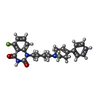Entry Database : PDB / ID : 1uk1Title Crystal structure of human poly(ADP-ribose) polymerase complexed with a potent inhibitor Poly [ADP-ribose] polymerase-1 Keywords / Function / homology Function Domain/homology Component
/ / / / / / / / / / / / / / / / / / / / / / / / / / / / / / / / / / / / / / / / / / / / / / / / / / / / / / / / / / / / / / / / / / / / / / / / / / / / / / / / / / / / / / / / / / / / / / / / / / / / / / / / / / / / / / / / / / / / / / / / / / / / / / / / / / / / / / / / / / / / / / / / / / / / / / / / / / / / Biological species Homo sapiens (human)Method / / / Resolution : 3 Å Authors Kinoshita, T. Journal : J.Med.Chem. / Year : 2004Title : Rational approaches to discovery of orally active and brain-penetrable quinazolinone inhibitors of poly(ADP-ribose)polymeraseAuthors : Hattori, K. / Kido, Y. / Yamamoto, H. / Ishida, J. / Kamijo, K. / Murano, K. / Ohkubo, M. / Kinoshita, T. / Iwashita, A. / Mihara, K. / Yamazaki, S. / Matsuoka, N. / Teramura, Y. / Miyake, H. History Deposition Aug 14, 2003 Deposition site / Processing site Revision 1.0 Sep 14, 2004 Provider / Type Revision 1.1 Apr 27, 2008 Group Revision 1.2 Jul 13, 2011 Group Revision 1.3 Dec 27, 2023 Group / Database references / Derived calculationsCategory chem_comp_atom / chem_comp_bond ... chem_comp_atom / chem_comp_bond / database_2 / struct_site Item _database_2.pdbx_DOI / _database_2.pdbx_database_accession ... _database_2.pdbx_DOI / _database_2.pdbx_database_accession / _struct_site.pdbx_auth_asym_id / _struct_site.pdbx_auth_comp_id / _struct_site.pdbx_auth_seq_id
Show all Show less
 Yorodumi
Yorodumi Open data
Open data Basic information
Basic information Components
Components Keywords
Keywords Function and homology information
Function and homology information Homo sapiens (human)
Homo sapiens (human) X-RAY DIFFRACTION /
X-RAY DIFFRACTION /  SYNCHROTRON /
SYNCHROTRON /  MOLECULAR REPLACEMENT / Resolution: 3 Å
MOLECULAR REPLACEMENT / Resolution: 3 Å  Authors
Authors Citation
Citation Journal: J.Med.Chem. / Year: 2004
Journal: J.Med.Chem. / Year: 2004 Structure visualization
Structure visualization Molmil
Molmil Jmol/JSmol
Jmol/JSmol Downloads & links
Downloads & links Download
Download 1uk1.cif.gz
1uk1.cif.gz PDBx/mmCIF format
PDBx/mmCIF format pdb1uk1.ent.gz
pdb1uk1.ent.gz PDB format
PDB format 1uk1.json.gz
1uk1.json.gz PDBx/mmJSON format
PDBx/mmJSON format Other downloads
Other downloads 1uk1_validation.pdf.gz
1uk1_validation.pdf.gz wwPDB validaton report
wwPDB validaton report 1uk1_full_validation.pdf.gz
1uk1_full_validation.pdf.gz 1uk1_validation.xml.gz
1uk1_validation.xml.gz 1uk1_validation.cif.gz
1uk1_validation.cif.gz https://data.pdbj.org/pub/pdb/validation_reports/uk/1uk1
https://data.pdbj.org/pub/pdb/validation_reports/uk/1uk1 ftp://data.pdbj.org/pub/pdb/validation_reports/uk/1uk1
ftp://data.pdbj.org/pub/pdb/validation_reports/uk/1uk1 Links
Links Assembly
Assembly
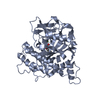

 Components
Components Homo sapiens (human) / Plasmid: pGEX4T-2 / Production host:
Homo sapiens (human) / Plasmid: pGEX4T-2 / Production host: 
 X-RAY DIFFRACTION / Number of used crystals: 1
X-RAY DIFFRACTION / Number of used crystals: 1  Sample preparation
Sample preparation SYNCHROTRON / Site:
SYNCHROTRON / Site:  Photon Factory
Photon Factory  / Beamline: BL-6B / Wavelength: 1 Å
/ Beamline: BL-6B / Wavelength: 1 Å Processing
Processing MOLECULAR REPLACEMENT / Resolution: 3→30 Å / σ(F): 1 / Stereochemistry target values: Engh & Huber
MOLECULAR REPLACEMENT / Resolution: 3→30 Å / σ(F): 1 / Stereochemistry target values: Engh & Huber Movie
Movie Controller
Controller


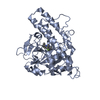
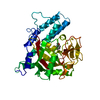
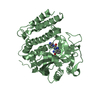

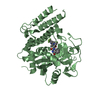

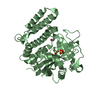
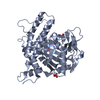

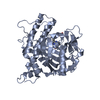

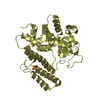
 PDBj
PDBj





